April 13, 2023
Webinar: Acceptance and Commitment Therapy Tools For Anxiety
Written by Rachel Eddins
Posted in Anxiety, Webinars and with tags: Anxiety, types of therapy
Acceptance and Commitment Therapy, also known as ACT, is a mindfulness-based counseling approach used to help individuals maximize their potential for a rich, full, meaningful life through values-based living.
This presentation will cover practical skills utilizing ACT for dealing with anxiety.
This webinar is facilitated by Kelsey Engdorf, a therapist in our Sugar Land location, an LPC- Associate supervised by Heather Dunn.
Watch a replay of the presentation here.
Learn more about anxiety and Acceptance and Commitment Therapy (ACT).
Anxiety Tools
Hi, everybody! Today, we’re going to talk about a specific type of therapy known as Acceptance and Commitment Therapy (ACT).
We’re going to be specifically talking about that type of therapy as it relates to anxiety and how it can help us to better manage our anxiety, and live our lives more fully while we’re dealing with some stress or some anxiety.
My name is Kelsey Engdorf. I am a Licensed Professional Counselor associate (LPC-A) at Eddins Counseling Group.
I noticed there are some people from different cities, even different countries, which is really exciting. I’m in Houston, Texas. I work at our Sugar Land office (if people are from the area).
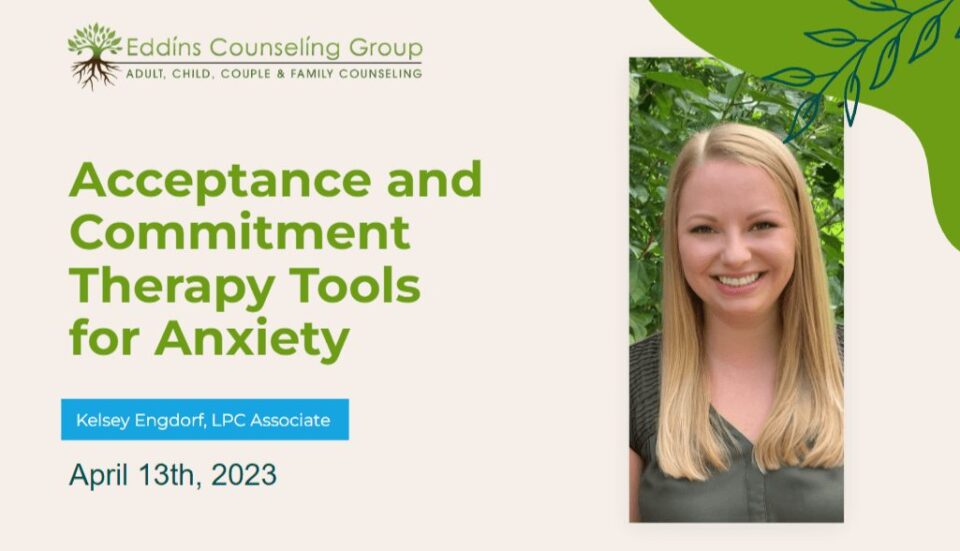
I picked this topic because I have some additional training with this specific type of therapy, and I’ve used it with quite a few clients. They’ve mostly found it very helpful, and I have personally found it to be really helpful too.
I’m assuming that because you all came to this talk (well, you may or may not be a clinician), you probably struggle with anxiety yourself. Feelings of anxiousness, stress, feeling overwhelmed.
Does anybody feel like their anxiety has gotten to the point at times where it really gets in the way of how they want to live?
Anxiety really limits what you feel like you can do:
- Maybe you want to start dating again, but you feel too anxious?
- Maybe you want to start a business?
- Maybe you just feel like you can’t really be present because of all your anxious thoughts?
Hopefully, we can help out with a little bit of that today.
This is part of a free monthly webinar series on a variety of mental health topics that Eddins Counseling Group offers once a month on a variety of mental health topics.

ACT Therapy to Help Us Handle Anxiety
Learn practical tools for handling anxiety using the Acceptance and Commitment Therapy framework:
- Values & committed actions
- Cognitive defusion skills
- Willingness skills
- Attention to present moment activities (mindfulness activities)
Here are a couple of objectives, that we’re going to be talking about in the presentation.
We’re going to learn practical tools for handling anxiety using the Acceptance and Commitment Therapy (ACT) framework.
Talking about values and committed actions, something called cognitive defusion/diffusion, skills for that, willingness skills, and attention to present moment activities, otherwise known as mindfulness activities.

What is Acceptance and Commitment Therapy (ACT)?
- Acceptance and Commitment Therapy (ACT) is a unique empirically based psychological intervention that uses acceptance and mindfulness strategies, together with commitment and behavior change strategies, to increase psychological flexibility.
- “3rd wave” cognitive behavioral therapy; based on relational frame theory
- What makes ACT unique from other types of therapies:
- Pain is part of being human
- It’s about moving toward the life you want to live with your problems
- Symptom reduction is not the focus
Just a little brief information about Acceptance and Commitment Therapy (ACT):
ACT is a unique, empirically based psychological intervention that uses acceptance and mindful strategies together with commitment and behavior change strategies to increase something called psychological flexibility.
Now, that’s a lot of words.
Basically just means a few things:
Psychological flexibility means remaining in the present moment, staying open to whatever thoughts and feelings show up (good or bad), and taking action in service of our values.

It’s a type of third-wave cognitive behavioral therapy or CBT. It was developed in the 80s, so it’s a little bit newer.
There’s a good amount of research showing the effectiveness in treating a variety of mental health concerns and brief information on relational frame theory. So that’s what it’s based on. It’s a pretty complex theory.
One thing that the RFT or relational frame theory says is that our brains are a bunch of different connections. So we might be able to form connections from any seemingly unrelated objects. And sometimes that happens in the way of opposites.
I’m sure this has happened to quite a few people. You might have had a happy moment where everything seems good, and then your mind immediately goes to something sad or sadness.
I wish this person was here with me, or I know this happiness can’t last forever. So based on relational frame theory, one reason for this is that happiness is the opposite of sadness.
So our brains sometimes automatically go to feeling sad when we’re feeling happy. That’s part of the theory.

What Makes ACT Therapy Different from Other Types of Therapies?
One thing that is a little bit different is Acceptance and Commitment Therapy or ACT says that pain is just part of being human, and this includes emotional pain, unfortunately.
It’s really how we relate to or handle the pain is the part of it we can control because oftentimes we can’t control our pain. It’s about moving toward the life you want to live with your problems.
So not necessarily despite your problems or once you get better, once you get over your anxiety, you’re going to start living. It’s about trying to live right now with your anxiety.
One way to think about that, is you can think of yourself as a bus driver.
On your bus of life, you have a lot of different passengers.
- You have anxiety on the bus.
- So, you have sadness,
- You have pain, but
- You also have happiness.
- You have relationships with others,
- Your career, and
- so many different things.
Even though you might want to kick anxiety off the bus, you might want to kick pain off the bus. It’s about living your life.
It’s about driving your bus, even with all those negative inner experiences, and all those negative emotions that come up from time to time.
Symptom reduction is not the key. It’s not the focus of Acceptance and Commitment Therapy or ACT. Symptoms reduction is definitely a byproduct and it definitely tends to happen, but it’s not the direct focus.
We’re not going to talk about how we can control our anxiety or lessen it, but how we can live, how we want to live, even with our anxiety present at times.
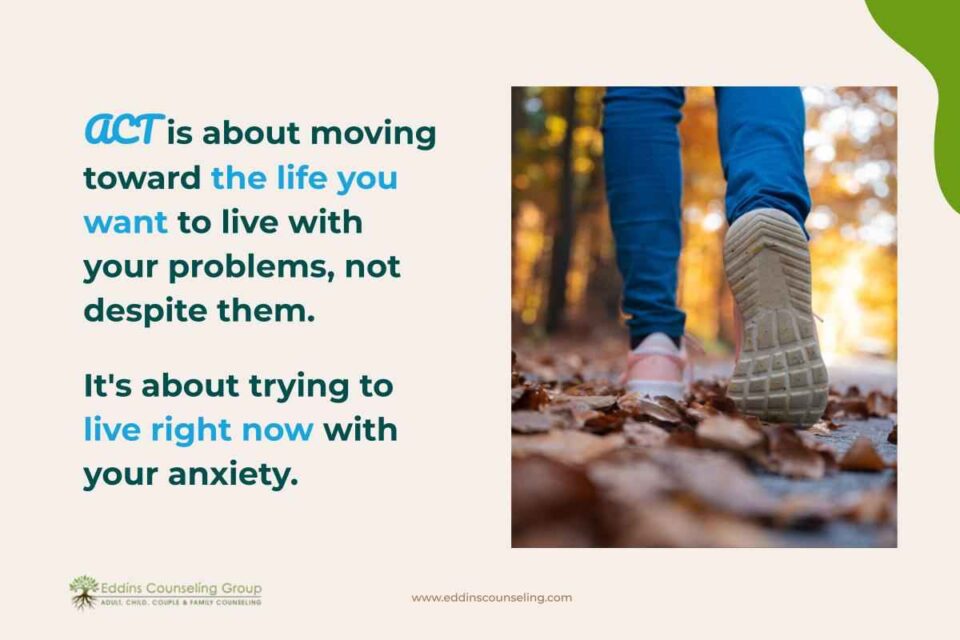
What Is Anxiety?
When Is It Helpful? When Is It Unhelpful?
- Anxiety – a feeling of worry, nervousness, or unease, typically about an imminent event or something with an uncertain outcome.
- While anxiety and stress are different, they are often used interchangeably
- Workability – is it helpful?
Anxiety is, in one definition, a feeling of worry, nervousness, or unease, typically about an imminent event or something with an uncertain outcome.
So anxiety is a really normal part of life when you look at it like that. In fact, anxiety can be really helpful at times. If we didn’t have any worries about the future, we would probably put ourselves in some dangerous situations.
Like back in the day, we may have gotten too close to an animal that could attack us.
Nowadays, anxiety can help us in a variety of ways. We’re worried about failing a test that might give us the motivation to study.
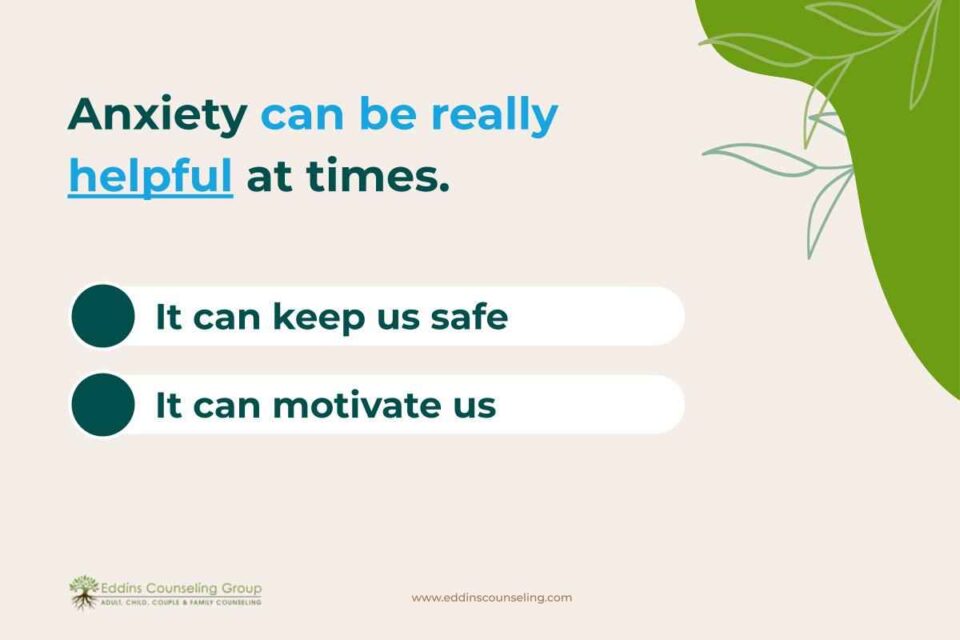
But I’m sure as a lot of you know, it can become very problematic and start interfering in our lives in a really negative way.
Let’s say, for example, you have driving anxiety. That’s definitely problematic. It can feel paralyzing.
It can be caused by a variety of factors not limited to biology, such as our neurotransmitters, trauma, current life situations, lack of resources, lack of sleep, and just so many different things that can contribute to our anxiety.
According to Acceptance Commitment Therapy ACT, one of the major ways that anxiety becomes problematic is that:
- the more we attempt to control our negative feelings, …
- the more we’re fused with our thoughts, …
- the more we’re pushed around by our thoughts, …
- the more our thoughts dictate our behavior and in the ACT framework, …
- that’s where the problems arise.
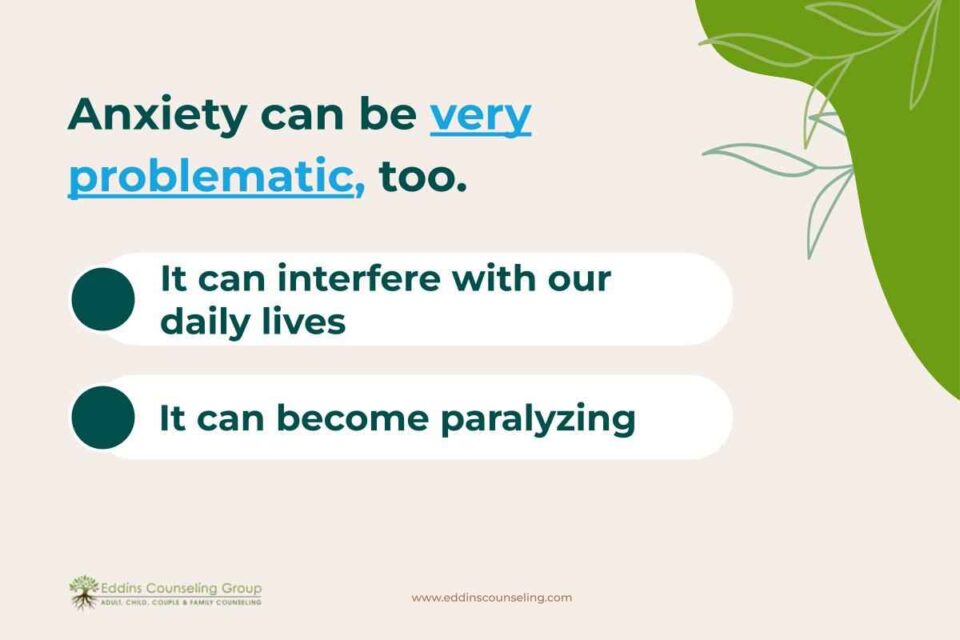
Are Stress and Anxiety the Same Thing?
While Anxiety and Stress Are Different, They Are Often Used Interchangeably.
We’ll use them interchangeably here because I’m not too much of a stickler for the differences.
So one big concept in Acceptance and Commitment Therapy ACT is the concept of workability. Is it helpful?
Is what we’re doing, what we’re thinking, and how we’re acting, is it pushing us toward the life that we want to live, or is it pushing us away from the life we want to live?
And that’s basically what workability means.
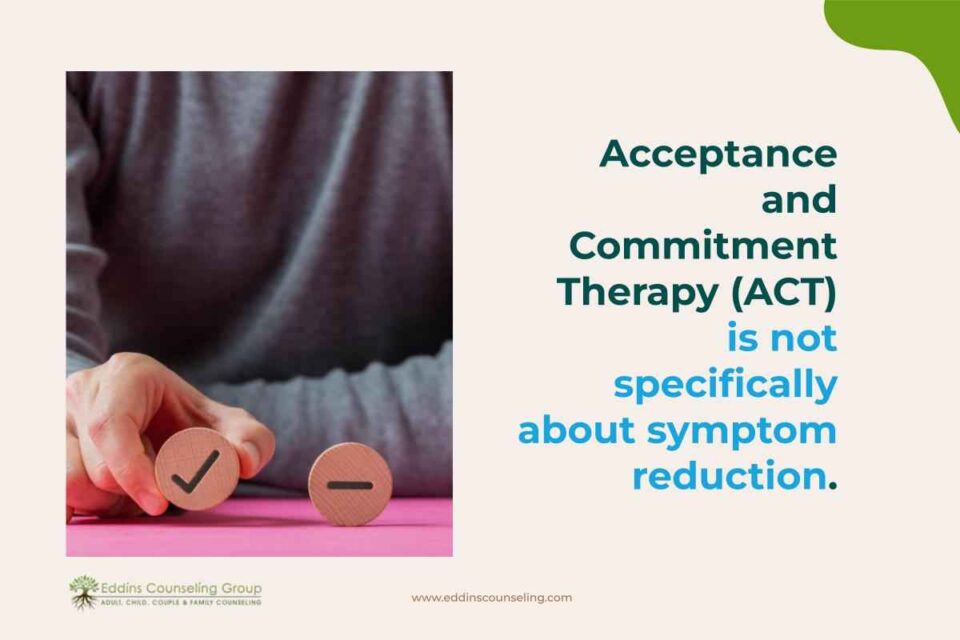
Ways To Help Mental Health
- Sleep
- Eating patterns
- Exercise
- Close social ties
- Processing past traumas
- Getting out in nature
So before we get into the more ACT-specific type of things, I wanted to talk especially on anxiety, and I want to talk about a few things just in general that can improve mental well-being.
Some of these might be obvious, but I wanted to go over them briefly. As I said, Acceptance and Commitment Therapy ACT is not about symptom reduction specifically or about necessarily decreasing anxiety.
However, there are things we can do to help overall with our mental health that in turn are possibly or most likely going to reduce our anxiety.
Sleep
So the first one is sleep. I’m sure everybody knows that pretty much, but I really feel like that’s the foundation of mental health.
If we’re not getting sleep, our anxiety is going to be worse.
We’re probably going to feel more depressed. We’re not going to be able to concentrate. But I know this is so hard at times because of stress, because of current life circumstances, biology, and just all the things that interfere with our sleep.
There is a book listed called “Why We Sleep”. So that talks all about sleep and how to get better sleep, hopefully.
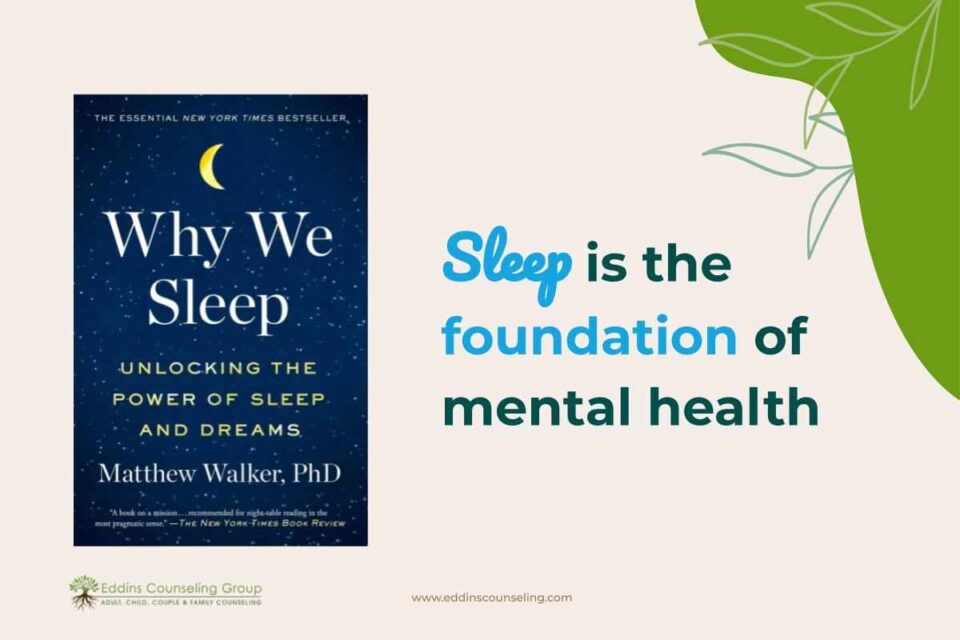
Eating Patterns
The next one is eating patterns.
There’s more and more research being done that shows what types of food we eat, and how they contribute to our mental health and our overall well-being.
Nutrition research is pretty messy. But what we do seem to know is that processed foods tend to be correlated with poor mental health.
Also, eating enough protein and healthy fats tends to be correlated with more positive mental health. I know there are so many different diets out there, but that seems to be what we know.

Exercise
Exercise has been studied pretty extensively. There’s some mixed research out there, but overall, that’s something that in the research really tends to reduce our stress and help us feel overall better.
Close Social Ties
Having close social ties. We’re social beings, so if we’re isolated, that can really contribute to poor mental health.
However, this is another area that’s really, really tough. If we struggle with social anxiety or we have to move around a lot, those types of things.
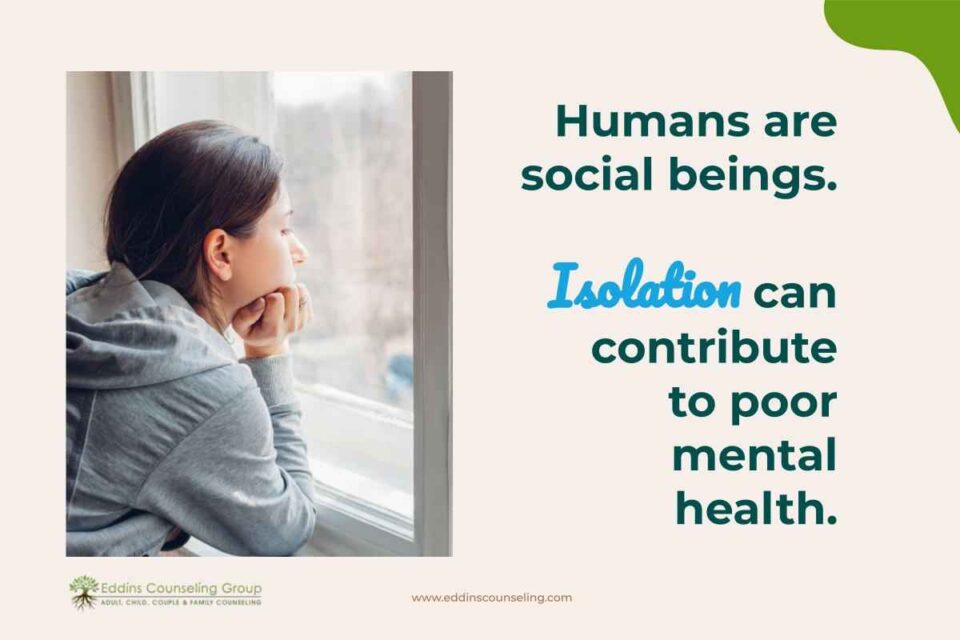
Processing Past Traumas
Processing past traumas is the next action that can improve your mental health. I believe that one’s hugely important and that can be a direct contributor to our anxiety or other problems.
And it doesn’t necessarily mean that it’s a huge thing like a horrible car accident or fighting in a war.
It can be smaller things like maybe a parent who wasn’t really there for you as a kid or being bullied in school, those things.
And those things are worked out best, I believe, with a trained trauma therapist or somebody who’s specialized in training.
Getting Out into Nature
Getting out into nature, that’s another one.
The research tends to be pretty clear that that can reduce our stress and just improve our mental health overall.
I just wanted to go over those things. So now we’ll get on to more act-specific type things.

What Are Your Values?
How We Know Where We Want to Go
Values are a way of clarifying our direction and purpose. They are how we decide what is important to us, and what is not so important.
One way to define values is to think of them like a compass. They are there to guide our behavior, on an ongoing basis, to achieve our goals and live a more meaningful life.
Values are a huge part of Acceptance and Commitment Therapy ACT. One of the key parts of it is focusing on our values. So it’s how we know where we want to go.
They’re a way of clarifying our direction and purpose. They’re how we decide what is important to us and what’s not so important.

One way to define values is to think of them like a compass. They’re there to guide our behavior on an ongoing basis to achieve goals and live a more meaningful life.
As I said, they’re like a compass. They’re different from goals. A goal is something that we can accomplish, like graduating from college. Once we accomplish that, we can check it off. It’s done. That’s behind us. Values are never complete. They’re ongoing.
So if we wanted to head to Louisiana, that would be our goal. And our value, in that case, would be heading east from Texas.
And if we got off track a little bit, all we would have to do is head back east to get back on track to our goal.
We can arrive in Louisiana, that’s the goal, but we can never arrive east. So in that scenario, east would be the value.
Our values may change over time. As we get older, they might become very different.

What Are Examples of Values?
So go ahead and take a look at this list of values. It’s certainly not all the values in the world, but it is a pretty good, comprehensive list.
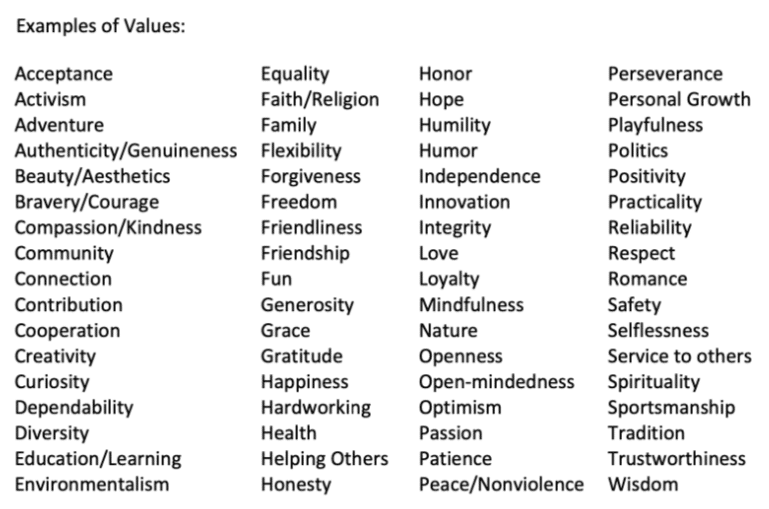
Core Values Exercise
- Pick 3-5 values from the previous slide (or any others that come to mind)
- Write down why they are important to you
- At the end of the day, list each top value. Then write one way you lived out that value.
- For example, if one of your top values is family, you might write that you had a family dinner or called a parent that day.
Pick 3-5 Values
What I want us to do is do a little exercise. Go ahead and take a look at this list or any others that come to mind.
If you can pick out 3-5 that you feel really resonate with you the most at this current stage of life.
Which ones do you feel are really the most meaningful to you?
Write Down Why They Are Important
One exercise you can do is take a moment right now or maybe later, and think about or write down, ideally, why these values are so important to you.
What they mean to you, and why they are something that you would like to live your life based on.

List Each Top Value
The third part of that exercise, at the end of the day, just list out your values. So list out love, passion, acceptance, or independence, and write down one way that you lived off that value that day.
Or if you’re more of a morning person, you can do: which values you intend to live out that day and how you intend to do that. So for example, if one of your values is family, you might say that you had a family dinner or you called a parent that day.
I know that seems very simple, and you might be like, how does this really help?
There’s been a lot of research focusing on values and how much that can really help us feel a lot more in control of our lives.
It can feel like we have a lot more meaning in our lives. It can feel like we’re a lot more fulfilled, like we’re really moving toward the life we want.
This is something to keep in mind, not just now, but ongoing. Keep in mind: “Based on my values, what life do I want to live? What type of life do I want to live? Or how am I currently acting on my values?”
And a lot of times, as I’m sure everybody knows, it can be pretty difficult to act on our values sometimes, especially when we’re having a lot of anxiety or other concerns.
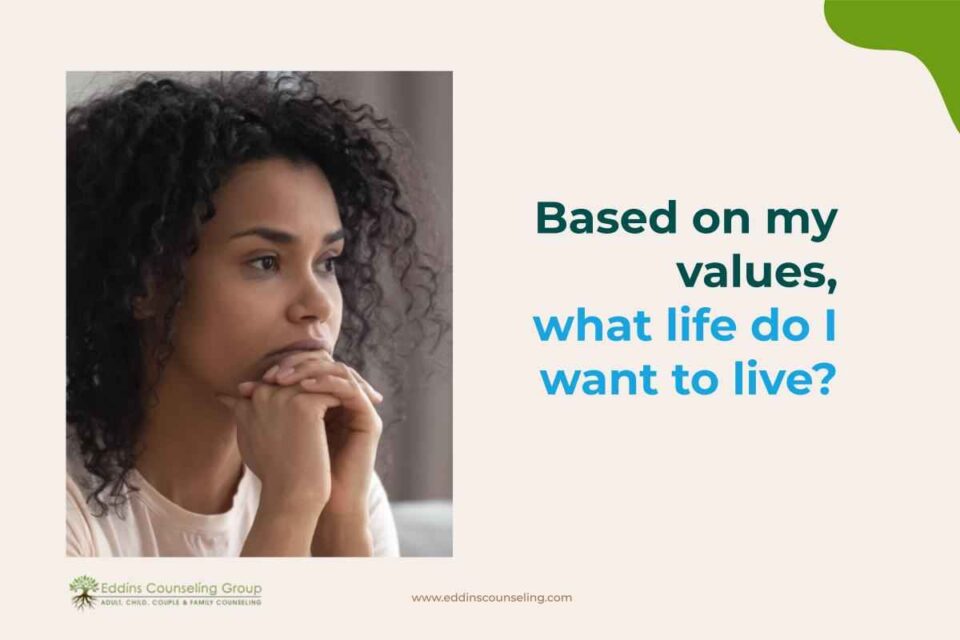
What Is Committed Action in ACT?
Committed action is another big part of Acceptance and Commitment Therapy ACT, and that’s the commitment part from “acceptance and commitment therapy”.
Behavior in the service of chosen values.
Basically just means that we’re acting in line with our values.
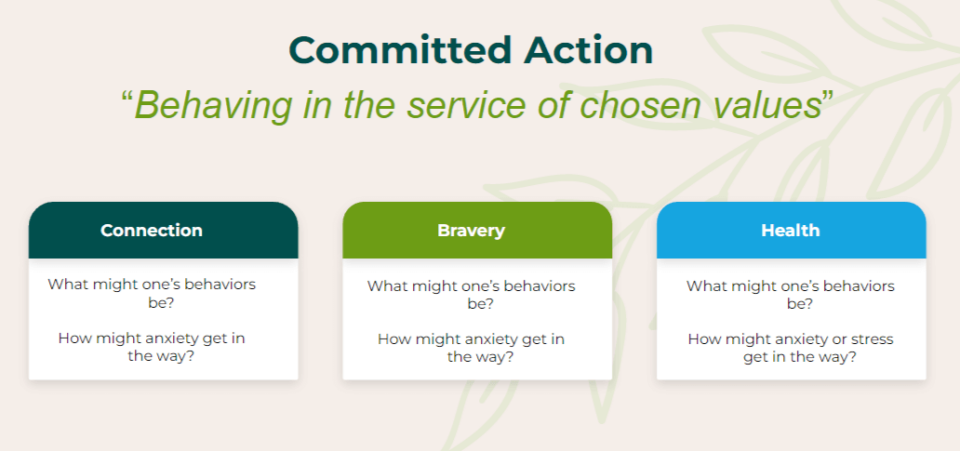
I put a couple of sample values up here.
Connection: what might one’s behaviors be? And then how might anxiety get in the way of that? Social anxiety, obviously, is a big one.
Health: We all know how much stress can affect us in making healthy decisions. If we had a really tough day, we might want to eat some sweets and not really be focusing on our health. So that is definitely a struggle.

Fusion vs Defusion in ACT Therapy
- Fusion: When our thoughts dictate our behavior; when we believe our thoughts are 100% true
- Defusion: Looking at thoughts rather than from thoughts; Noticing thoughts rather than becoming caught up in thoughts; Letting thoughts come and go rather than holding on to them
I know I was talking about how difficult it is sometimes to live out our values and do committed actions based on the values, like making healthy choices if health is one of our values.
It can be really tough, especially when we are what is called fused with our thoughts, being hooked by our thoughts, being pushed around by our thoughts.
This is something that might be new information, hopefully, to some people. Acceptance and Commitment Therapy ACT has a different way of looking at the thought.
In traditional cognitive behavioral therapy, the focus is on changing our thoughts. We have a thought: “I’m useless”. Your therapist might work with you to change that to: “I am powerful”, or whatever the opposite of useless would be.
In ACT, that’s not really the goal. The goal is to look at our thoughts for more of what they are. They’re just thoughts, which I know is very much easier said than done.
Fusion means that we are fused with our thoughts. We’re hooked by our thoughts.
It’s when our thoughts dictate our behavior when we believe our thoughts are 100 % true, which is pretty easy to do because they’re coming from ourselves.
We’re having these thoughts, we’re thinking “I’m useless”. It’s pretty easy to believe.
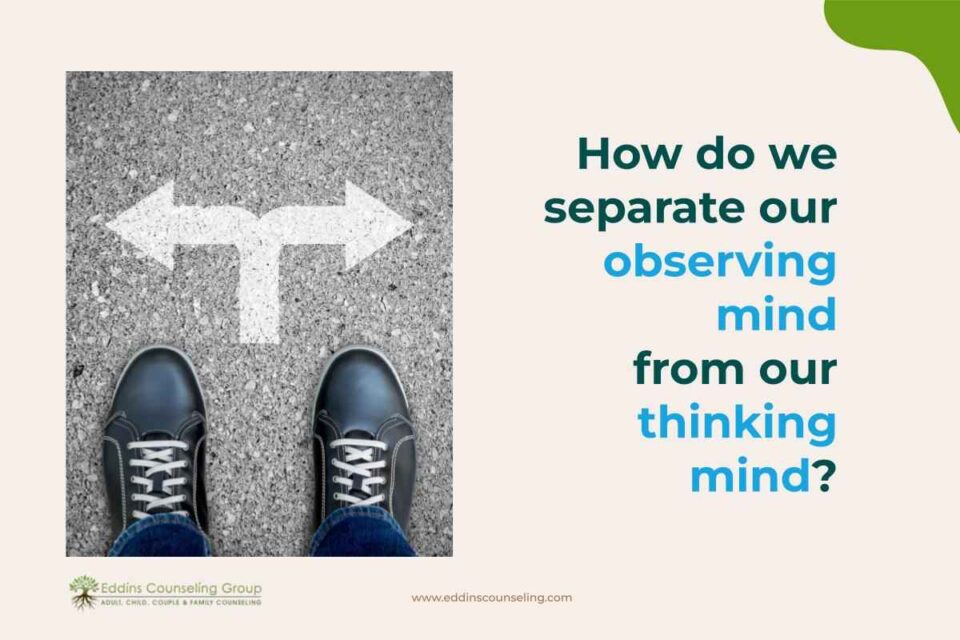
ACT Defusion
(noun) A skill or technique that is primarily used to detach, separate, or get some distance from our thoughts and emotions. (@thepsychologygroup)
Diffusion, it’s a technique creating some distance from our thoughts.
Diffusion is more of the idea of taking a step back, looking at our thoughts rather than from our thoughts, noticing our thoughts rather than becoming caught up in them, and letting them come and go rather than holding on to them.
When we are fused with our thoughts, we might believe them, like I said, as absolute truth. And when we believe our thoughts as absolute truth, they’re probably going to dictate a rule or behavior.
So believing thoughts such as “I’m useless” is not helpful, typically, and not conducive to living the life we want.
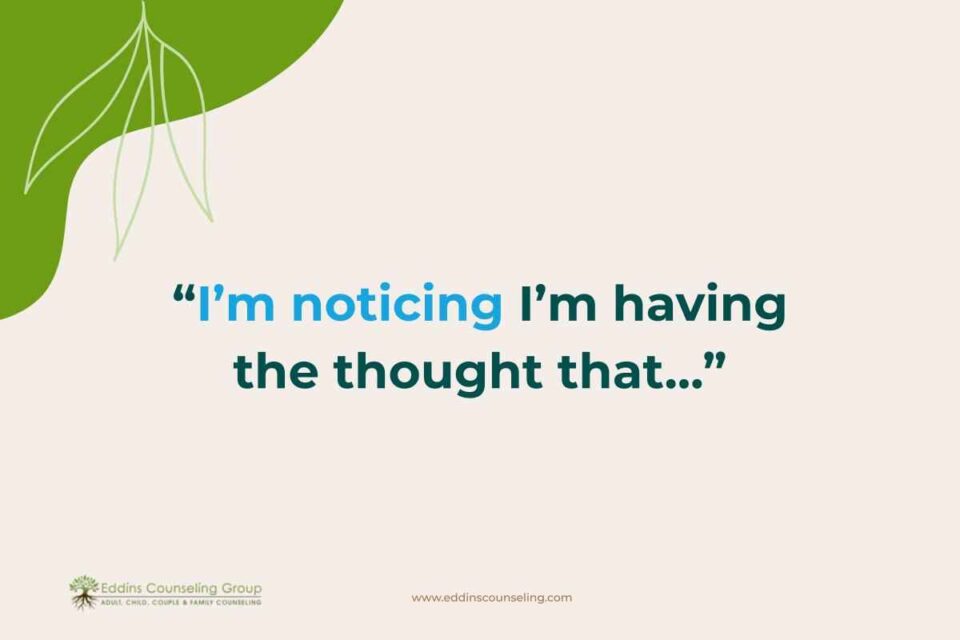
ACT Defusion Techniques
Decrease the influence of thoughts on our behaviors and experiences; Increase our ability to be present and take effective action.
How do we get some space from our thoughts? How do we separate our observing mind from our thinking mind? Here are a couple of diffusion techniques:
- ”I’m noticing I’m having the thought that…”
- Thank your mind
- Repeating the word until it loses meaning
- Say it in a silly voice or sing it
- Name it
- Place the thought on a cloud, leaf, etc.
The purpose of diffusion techniques is to decrease the influence of thoughts on our behaviors and experiences and increase our ability to be present and to take effective action.
So to do those things that we want to do that help us live out our values.
One that’s probably the most common one is “I’m having the thought that ____”, or “I’m noticing I’m having the thought _____”.
Let’s switch it up.
- Let’s say you’re having the “I’m stupid.”
- You might tell yourself: “Okay, I’m noticing I’m having the thought that I’m stupid.”
That might not seem too different, but if you practice it with maybe an intrusive thought that comes to mind, saying out loud:
- “I’m useless”, and then saying out loud,
- “I’m noticing I’m having the thought that I’m useless”.

Oftentimes, you can feel a little bit that it has a little bit less pull over you. Nothing’s a magic bullet, but that tends to switch things a little bit.
Thanking your mind, saying “thank you”. If your mind is worrying about the future, you can say: “Thank you, mind”. Very helpful. Kind of like talking to yourself.
Repeating the word until it loses its meaning is a big one. With the example: “I’m stupid”, you could repeat the word “stupid” for 30 seconds until it just seems silly or seems like a silly word and it loses its power a little bit.
Say it in a silly voice or sing it. Name it. Say that old “I’m a loser” story again.
Place the thought on a cloud, leaf, or something like that.
This is more of a visualization, a mindfulness meditation-type exercise where you might envision a stream and just you might envision placing your thought on a leaf and the leaf floating down the stream. That could be an example of that.
Acceptance and Commitment Therapy Techniques
Hold language lightly
- Pick and choose when to defuse
- The goal is not to “feel better” but to give us more space to move toward our values
- Defusion is not an attempt to avoid or suppress thoughts
- Although not the direct goal, it can help lower overall stress and anxiety
A few more thoughts about diffusion. The idea really of diffusion is just to hold language lightly. Pick and choose one to diffuse.
We have so many thoughts all the time. Our minds are pretty much constantly going.
There’s absolutely no way we can diffuse from every thought, catch every thought by any means.
When it is helpful to diffuse from our thought is when it’s unhelpful or when it’s something that’s moving us away from the life we want to live instead of toward it.
The goal is not to “feel better” but to give us more space to move toward the things that we want to do based on values.
It’s not an attempt to avoid or suppress thought. I know that’s definitely the natural thing to do is when we’re having negative thoughts, and when we’re having a hard time. Our automatic thing is to suppress it.
We want to avoid those thoughts, which is not the worst thing to do in the world.
However, research does suggest that the more we do that, that actually tends to make those thoughts typically come up more in the future.
It might help temporarily, but overall, as a long-term strategy, it’s not really the most helpful thing to do. And although it’s not the direct goal, it can help lower overall stress and anxiety.
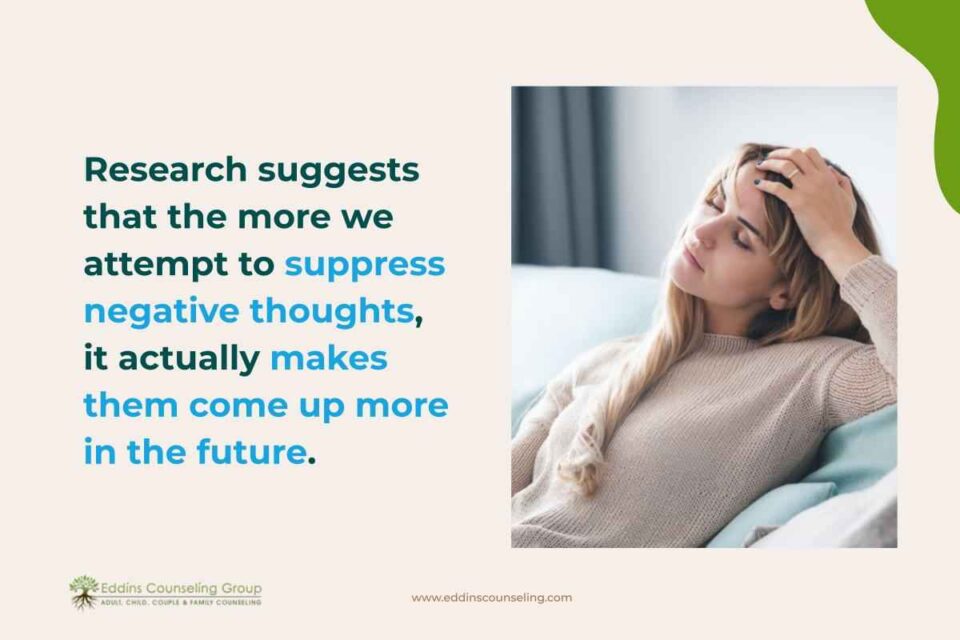
Steps For Defusion
Let’s go over some steps for diffusion.
- Identify thought
- Allow yourself to have the thought (ideally without judgment)
- Use defusion technique
First, you want to identify the thought.
Is it something helpful or is it not? For example, let’s say you’re worried that you’re going to get fired from your job. Is this thought helpful?
Well, maybe in some situations it is because maybe you’re doing something that your job you shouldn’t be doing, or maybe you need to work a little bit harder or talk to your boss or something. So in that situation, it can be helpful.
However, if you think you’re doing everything pretty much okay and you are very worried about getting fired for almost no reason, or it’s something you really have no control over, then maybe this would be a good thought to try diffusion techniques with.
Second, would be to allow yourself to have the thought, ideally without judgment. I know that’s something easier said than done, but just notice: “I’m going to get fired”.
Third, use the diffusion technique. For example, you could say: “Hey, I’m noticing I’m having the thought that I’m going to get fired”, or “Thank you, mind, for telling me that again”.
Then step 4 and 5, go back to whatever you were doing.
I know this is a hard thing to do at night when we’re trying to fall asleep because there’s really not much to get back to what we’re doing.
If we use diffusion techniques, the thought might come up again. You can always diffuse again or use a different technique.
As we know, there’s really no magic bullet, unfortunately.
Sometimes these techniques work better than other times, but they tend to be pretty helpful for the most part.
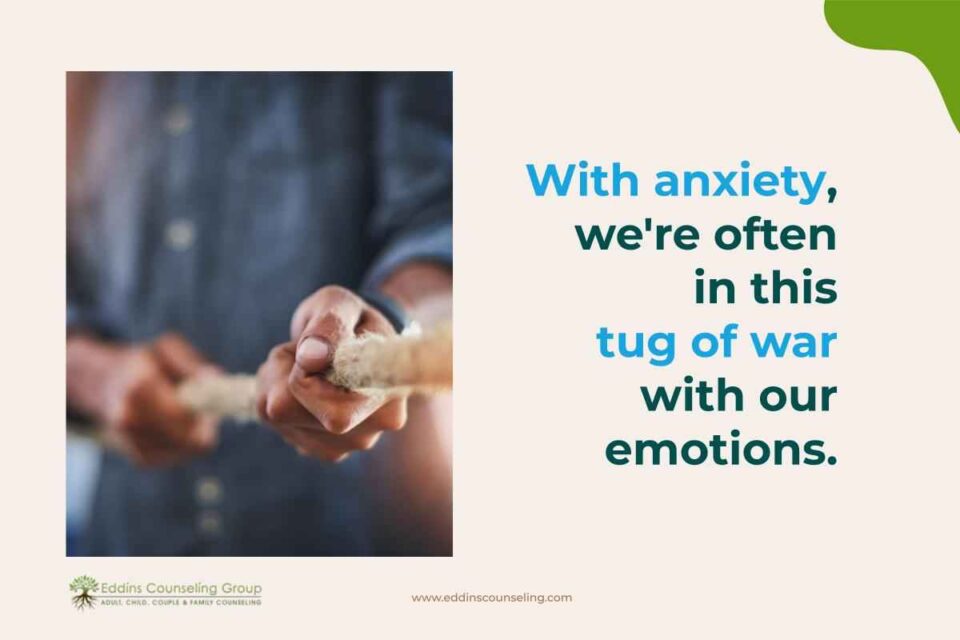
Experiential Avoidance vs. Willingness
Drop the rope
- Experiential avoidance: To avoid, suppress, or get rid of unwanted private experiences, even when it’s harmful, costly, or ineffective to do so
- Oftentimes, the more we try to control our inner experiences, the more intense or problematic they become
- Experiential avoidance is correlated with many negative outcomes including higher anxiety, more depressive symptoms, and lower quality of life.
- Willingness (aka Acceptance): Actively contacting psychological experiences directly, fully, and without needless defense
We’ll talk about another couple of Acceptance and Commitment Therapy ACT concepts.
So we’re going to talk about something called Experiential Avoidance versus Willingness and “drop the rope”.
“Drop the rope” is a big metaphor in ACT and Acceptance and Commitment Therapy. It’s really something meant to represent a metaphor for how we struggle with our emotions.
With anxiety, we feel anxious about something, and we try to push it down. It pulls us back a little bit.
We push away, it pulls us back. So we’re in this tug of war oftentimes with our emotions.
And in ACT, the metaphor is to drop the rope, to drop that struggle with that emotion.

What Is Experiential Avoidance in ACT?
The definition of experiential avoidance is to attempt to avoid, suppress, or get rid of unwanted private experiences.
So thoughts, feelings, and emotions, even when it’s harmful, costly, or ineffective to do so. In the tug-of-war scenario, this is when we’re pushing away our negative emotions.
Oftentimes (this is what research tends to suggest, and this is one of the things that Acceptance and Commitment Therapy or ACT frameworks are based on), the more we try to control our inner experiences, meaning emotions specifically, the more intense or problematic they become.
Experiential avoidance, meaning, trying to control, suppress, and push down any sadness, anxiety, or any negative emotions are correlated with many negative outcomes, including higher anxiety, more depressive symptoms, and overall lower quality of life.
Even though it seems counterintuitive, that tends to be what the research suggests. So the opposite of that is something called, I like to call “willingness”.
A lot of people call it willingness, but acceptance is the ACT-specific term for it.
I think willingness has become a very popular term too, but it’s the acceptance in the Acceptance and Commitment therapy.
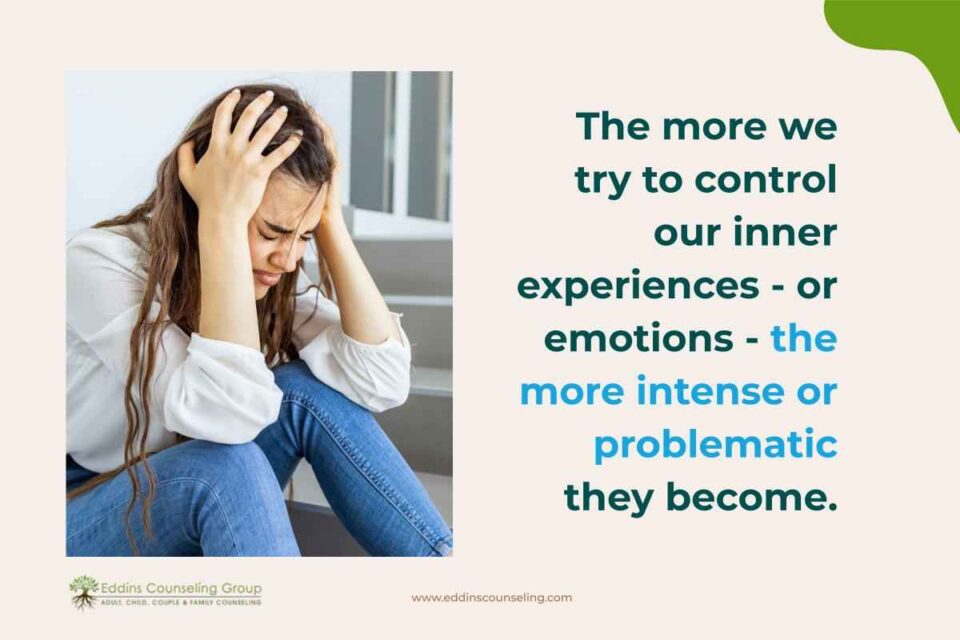
Acceptance does not mean that we’re accepting the life we have and not trying to make any changes.
That’s not at all what it means. So that’s why I prefer the word willingness.
It means actively contacting our psychological experiences directly, fully, and without needless defense. In that metaphor, it’s dropping the rope, essentially allowing ourselves to feel our feelings.
A caveat on that, of course, there are times when avoidance or pushing down our feelings might be helpful:
- If we’re at work, or
- If we’re having to do something, or
- If we had just extreme traumatic experiences in the past…
… that’s understandable until you get with a good therapist to not necessarily open those things up by yourself.
It’s also the other part of that. You can definitely go too far with willingness, too, because it’s not adaptive to sit around and feel sad all the time either. So there’s definitely a balance.
But the key is always pushing everything away, never allowing ourselves to feel our feelings, or very rarely allowing ourselves to feel our feelings is correlated with more negative outcomes. So we’ll talk about some ways to do that.
How To Practice Willingness?
Ways to feel our feelings
So here are ways to practice willingness, and ways to help us feel our feelings.
Obviously, just allowing ourselves to feel our feelings is one way.
I know that sometimes (for me included, that’s way easier said than done), a lot of people are so detached from their emotions, they’re not even really sure what their feeling may be.
Or the opposite, they just avoid their emotions because they’re just too overwhelming.
Body Scan
A couple of controlled things we can do to feel our feelings. One is a body scan.
This is a pretty common practice that maybe you’ve heard of or done yourself. So just mentally scanning your entire body from head to toe or toe to head.
Notice what sensations arise, whether it’s discomfort, tightness, calmness, heat, etc.
The key with the body scan when practicing willingness is trying not to change our emotions, not trying to calm ourselves down, but to notice the thing.
So it’s where that nonjudgmental piece comes in. Kind of like if we’re a scientist studying what our emotions are, just noticing those things.
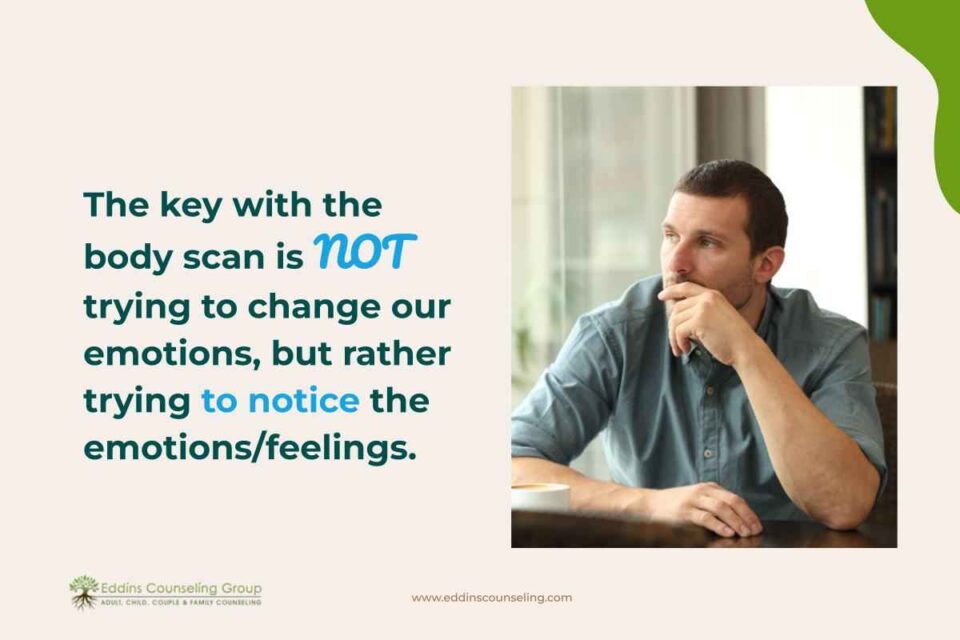
Turning Up the Willingness Style
Turning up the willingness style is something that is limited by time, not intensity. So here’s an example of what you could do.
You could say: “I’m going to allow myself to feel anxious, as anxious as my body wants to feel. I’m going to allow myself to feel anxious for 10 seconds, 30 seconds, or 1 minute”.
If it’s a lot of trauma, a lot of things happen, that probably wouldn’t be the best thing to think of or the best thing to use.
But maybe think of something recently that got your anxiety a little bit high. You could use that to try to drum up those emotions.
Or maybe you are already in a situation where you’re feeling anxious and you just want to allow yourself to be able to have those feelings, but it just feels too scary to just let yourself feel so you can set a timer.
Imagine you had a dial in yourself that turned up your anxiety and just let yourself feel that for X amount of seconds, minutes.
And then once that’s over, then you can go back to doing whatever you were doing before, maybe even doing something to help yourself relax after that.

Visualize the Feeling
Visualize the feeling, by assigning properties to your feelings, color, shape, size, weight, and temperature, which can make it feel a little bit more manageable.
- So if your anxiety was a color, what color would it be?
- If it was a shape, what shape would it be?
- How big would it be?
- How heavy would it be?
Those types of things.
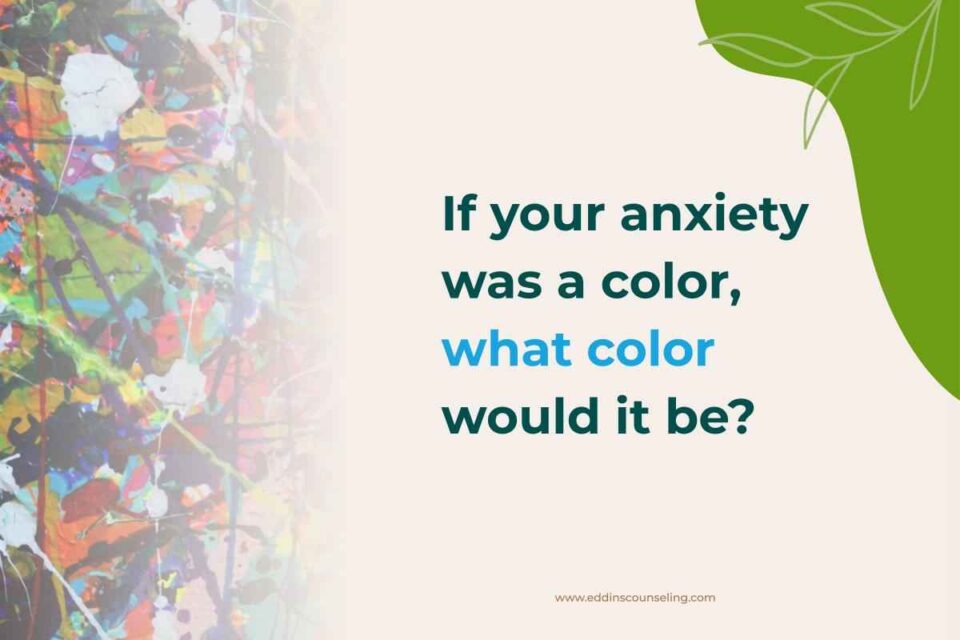
The Willingness and Action Plan
My goal is to (be specific):
The values underlying my goal are:
The actions I will take to achieve that goal are (be specific):
The thoughts/memories, feelings, sensations, urges I’m willing to make room for (in order to achieve this goal):
- Thoughts/memories:
- Feelings:
- Sensations:
- Urges
- It would be useful to remind myself that:
- If necessary, I can break this goal down into smaller steps, such as:
This worksheet is something that I thought I found recently. It’s a PDF you can download offline, and it ties together a lot of the things we’ve been talking about today.

Willingness vs. Defusion
- Neither are attempts to suppress or change our inner experiences (thoughts, feelings, etc.)
- Although you can use defusion techniques for both thoughts and feelings, it is typically more helpful to defuse from unhelpful thoughts and let ourselves feel our feelings
- Both are done with the intent of helping us move toward the lives we want
- Focus on what is helpful or adaptive
- Balance is key
When I first learned about these things, I felt like they were almost a little bit opposite.
Willingness is feeling our feelings fully and diffusion seems to be pulling ourselves away.
But it’s really not that simple.
Neither attempts to suppress or change our inner experiences.
Although you can use diffusion techniques for both thoughts and feelings, it’s typically more helpful to diffuse from thoughts and unhelpful thoughts and let ourselves feel our feelings.
However, there are lots of times when it could be really helpful and beneficial to do those diffusion techniques with our emotions.
Like I said, if it just feels way too overwhelming at the time, or you have to do something, let’s say you’re at work and you don’t want to break down crying, say: “I’m noticing that I’m feeling sad”.
Or placing your feelings on a leaf and watching it flow by.
Both are done with the intent of helping us move toward the life we want.
- Diffusion is helping us get a little bit of space from our thoughts that we feel are bossing us around, and
- Willingness helps us to be able to feel like we can tolerate our emotions a little bit more.
And again, I know I said it is counterintuitive, but if we can feel our feelings a little bit more, that typically helps us feel a little bit better overall and move toward the life we want.
Focuses on what’s adaptive or helpful. Again, nothing’s cut and dry.
Nothing’s like you diffuse with this and you are willing to feel your feelings 10 minutes a day. Nothing’s that specific.
Balance is the key.
As I said, both are done with just trying to help us live the lives we want based on values.

How To Be Present in the Moment
AKA Mindfulness
- Our minds often tend to live in the past or future.
- By purposefully focusing our attention on the current moment, we can train our minds to become more present
The attention to the present moment is a really big part of Acceptance and Commitment Therapy ACT as well. That’s mindfulness, essentially.
Think attention to the present moment is a little bit more specific. So our minds tend to live in the past or future.
I was reading online that research suggests our minds are “there and then” 47% of the time which I actually felt was a little bit low for some people. I feel like a lot of people are probably not in the here and now the majority of the time.
By purposely focusing our attention on the current moment, we can train our minds to become more present. This is done in an attempt to move toward the likely one.
I think not everybody, but I would say for the majority, people do want to feel a little bit more present.
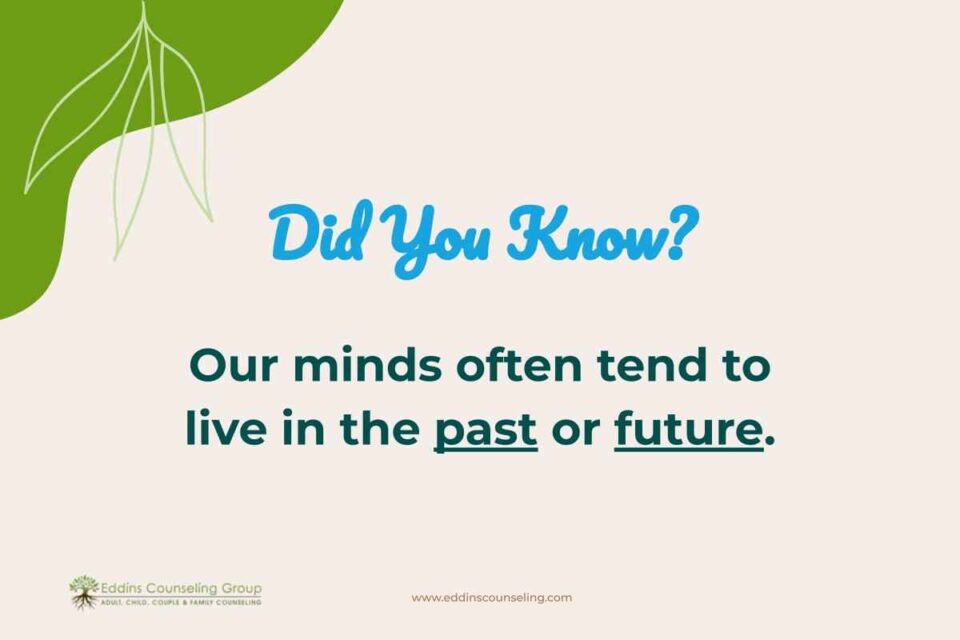
Mindfulness Activity for Adults
- 5 senses
- Focusing on one sense
- Breath focused meditation
- Notice when sitting down
- Mindful daily activities
- 1, 2, 3 freeze
These are some activities that you can practice.
With mindfulness or present moment activities, really the best thing to do is just do them and do them as much as you can. I definitely struggle with that as I’m sure most people do.
Five Senses Exercise for Anxiety
Five senses is one activity. This is basically just going through your senses. You could do it a couple of different ways. But one way is:
- What’s one thing I can see?
- What’s one thing I can hear?
- What’s one thing I can smell?
- What’s one thing I can taste?
- What’s one thing I can touch?
Or you can:
- What are five things I can see?
- What are four things I can hear?
- What are three things I can smell?
- What are two things I can taste?
- What’s one thing I can touch?
You could focus on one sense, maybe whatever sense is most prevalent.
So let’s say you’re looking at a really beautiful sunset or something in nature and just really trying to focus all your attention on your vision.
Or you’re at a concert, really trying to focus all your attention on your auditory sense.

How To Do Mindfulness Meditation?
Breath focused meditation is mindfulness meditation. You don’t have to use breath, you can use anything.
When you use breath, it’s focusing on that sensation of your breath entering your body and exiting your body. Or focusing on your stomach going in and out. Just picking one part of the breath to focus on.
And of course, you’re going to continuously get distracted. You’re going to be thinking about the past, the future. It’s all going to be coming up.
The purpose of this is to get that practice of bringing us back to the present moment, bringing us back to our breath.
That might be every two seconds. Or you might never.
But the more you do it, the easier it becomes.
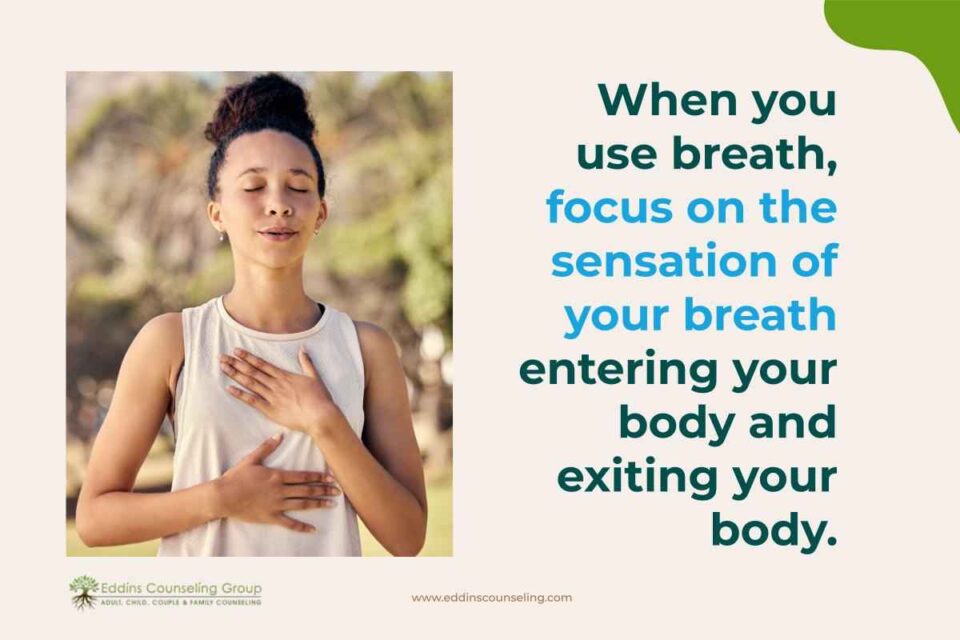
Notice When You’re Sitting Down
Notice when you’re sitting down.
So if you can keep in your mind: “Every time today that I sit down or stand up, I’m going to really try to notice it. I’m going to try to be in my body, feel that feeling”.
That’s one that is a little bit difficult to remember, but when you do, it gets you a little bit more in your body.
Mindful Daily Activities
Any mindful daily activities.
So that’s brushing your teeth, eating, showering, and being mindful.
There’s so much information online you can find about those types of things.
So definitely Google it if you’re interested in more. But basically, it’s just focusing again on your sensations.
So, for example, you might be brushing your teeth. You’re really focusing on the bristles on your teeth. And of course, your mind is going to wander.
The purpose is you’re going to just want to keep coming back to that sensation.

One, Two, Three, Freeze
One, two, three, freeze is something my four-year-old likes to do. This is a good one with kids, but adults can do it too.
So, for example, you walk for three seconds. You go 1,2,3, and then you freeze.
And you say one thing that you can see. Then you do it again, 1,2,3, and freeze. And you notice something else you can see.
These are just things that train our minds to be a little bit more present, be a little bit more able to focus on the things that we want to focus on rather than the things we don’t want to focus on, of course.

Questions
How to calm racing thoughts?
I don’t know if it’s one of the best things, but one thing that I would really suggest with racing thoughts is to try some mindfulness activities. Maybe the “leaves on the stream” activity, so you can Google that.
Imagine yourself on a nice riverbank on a nice day and you close your eyes to help the visualization and you place a thought on the leaf and it goes by and it’s probably quick.
Maybe when your mind is raised, maybe you’re putting your thoughts on the leaves so quickly.
The racing thoughts are hard because sometimes it’s really hard to slow our minds down.
But again, maybe with the leaves on a stream or the mindfulness meditation, trying to refocus on the breath, your mind might be going, and just every millisecond you’re trying to refocus on the breath.
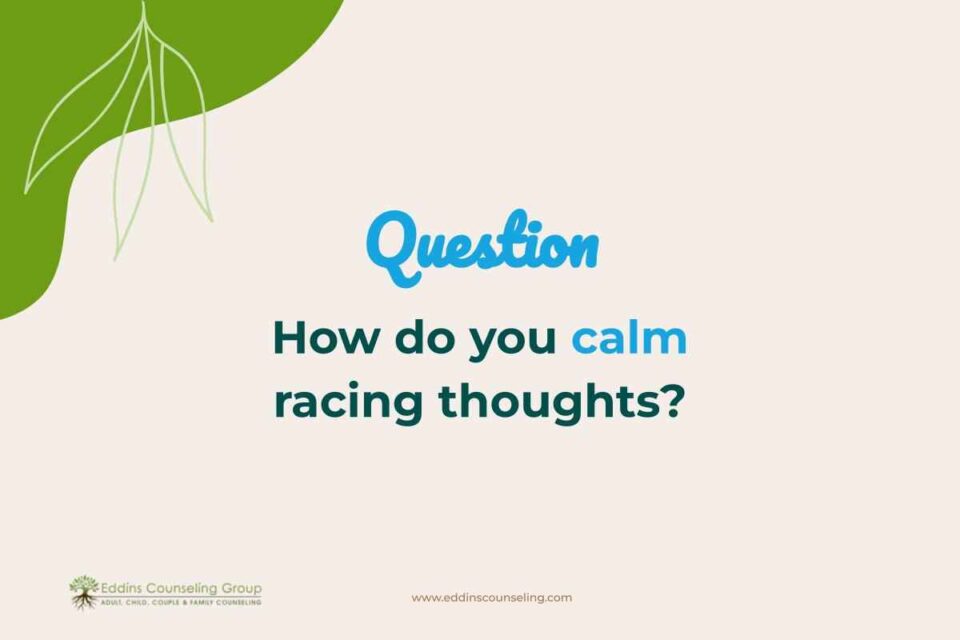
What about stress during moving?
So there is a lot of stress when moving. I’m sure some of that stress is very unhelpful because it’s probably not fun to go through. But it also sounds like a lot of that stress or like some of that stress could be pretty motivating, though.
Sounds like there are a lot of actions that you could take for that. But that’s really stressful when you don’t have a lot of money.
That is so tough. I wish there was an easy answer for that or a quick fix for that. But that sounds like just a really, really stressful situation.
Willingness and diffusion, when to use which?
This is not a clear-cut answer. I would say the general rule:
For Diffusion
For diffusion, mostly that’s with thoughts. But as I said, you can use it with emotions, too. So really, if you’re having a very unhelpful recurrent thought, because like I said, our minds are always going, going, going, going.
But if we have something that’s very recurrent, really bothersome to us, keeps coming up and it’s not helpful.
That’s something that you could try the diffusion techniques with and see if that helps you.
For Willingness
Willingness is something that when we’re having all the stresses of just being a human.
This includes having anxiety, sadness, and stress, just general advice on that is just to allow yourself to feel your feelings a decent amount of the time.
I know that that’s not a clear answer. I think everybody’s life is really different.
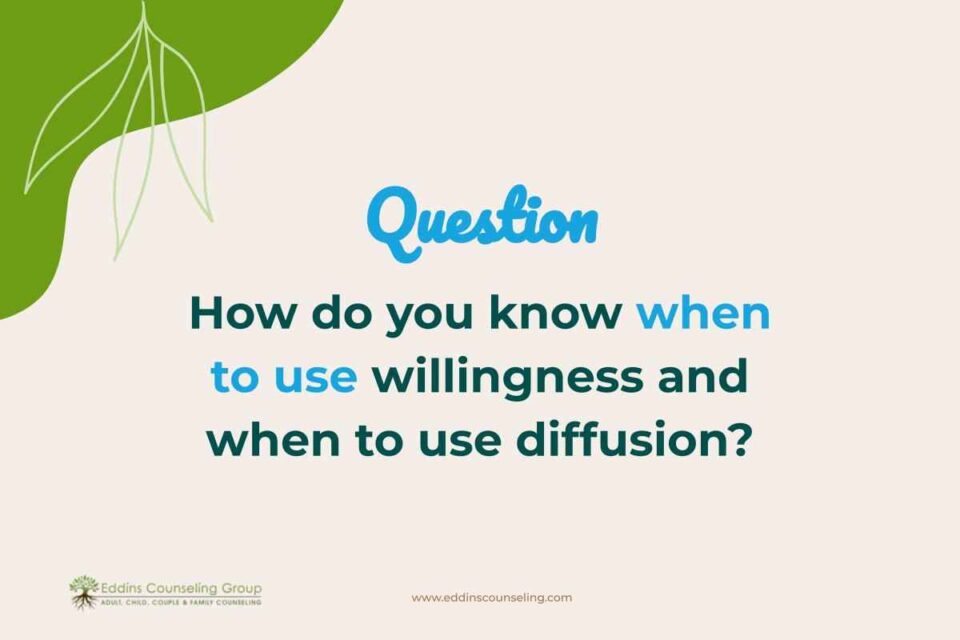
Everybody is in different spots where maybe they feel like they can tolerate feeling their feelings a little bit more.
For some people, it might feel really scary to allow yourself to really, truly feel your anxiety or really, truly feel sadness. And maybe some people might feel those things all the time, every day.
So I understand that there’s that, too.
You might be saying: “I already do feel my feelings”.
That could be very well true.
A lot of times when we’re pushing them down or we’re having that tug of war with them all the time, we’re just doing distraction, we’re doing:
“Okay, how can I make myself feel better? I’m going to eat something, I’m going to going to do this. Or, I’m going to watch TV. I’m going to drink, use drugs, anything…”
If we’re constantly doing those things to avoid our feelings, that’s when things start to get problematic.
There’s no prescription to feel your feelings 10 minutes a day.
I would say just how much you can tolerate and try those techniques.
Try the body scan just to feel what’s going on in your body.
Try the willingness. I believe it is in one of the books that I put at the end.
Turning up the willingness out, you feel like that’s doable for you to sit down and say:
“Okay, for one minute, I’m going to just allow myself to feel my anxiety without judgment. It’s not going to kill me to feel it.”
But again, there are caveats to that. I know everybody is in a different situation. I know that a lot of times it can feel a lot more overwhelming than others.

We feature a unique topic on the second Thursday of every month from 7-8:00pm.
About the Facilitator
My name is again, my name is Kelsey Engdorf. I’m an LPC Associate. I see adolescents, teens, adults, and couples in person in Sugar Land, which is right outside of Houston or virtual.
My email address is [email protected]. Feel free to email me.
For more information about our practice, call (832) 559-2622 or text (832) 699-5001 those numbers. We have a really good website here.
Act Therapy Books and References
- A Liberated Mind by Steven C. Hayes
- Get out of Your Mind and Into Your Life by Steven C. Hayes
- https://thepsychologygroup.com/defusion/
- The Confidence Gap by Russ Harris
- The Happiness Trap by Russ Harris
- The Mindfulness and Acceptance Workbook for Anxiety by John P. Forsyth & Georg H. Eifert
- Why we Sleep by Matt Walker
- Willingness and Action Plan
Here are the resources. There are a couple of books by Steven C Hayes. He’s the one who created Acceptance and Commitment Therapy or ACT.
Also, a couple of websites, and the “Willingness and Action Plan” worksheet.
Then, “The Mindfulness and Acceptance Workbook for Anxiety”. If that’s something you’re really struggling with, the anxiety, I would definitely check that book out.
Thank you all so much. I am so happy that everybody came today.
It’s definitely nice to be able to put this together. I really like all this stuff. As I said, it’s helped me personally.
Nothing’s a quick fix. Nothing fixes everything.
I found this to be really helpful so I’m just really happy to be able to share it with everybody. I’m so happy you all were able to come.
Thank you for the comments and the nice thoughts.
5 Ways to Reduce Anxiety
Get instant access to your free ebook.
Grounding & Self Soothing
Get instant access to your free ebook.
Create Healthier Thoughts & Feelings
Get instant access to your free ebook.
Why You Feel This Way
Get instant access to your free ebook.



















